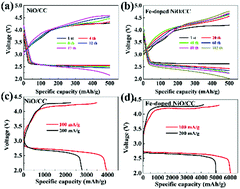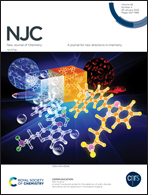Synthesis of Fe-doped NiO nanosheets on carbon cloth for improved catalytic performance in Li–O2 batteries†
Abstract
Compared with common lithium-ion batteries, Li–O2 batteries are recognized as attractive power systems owing to their superior high theoretical specific energy. However, sluggish dynamic processes, including the oxygen reduction reaction (ORR) and oxygen evolution reaction (OER), need to be overcome to allow their practical application. Here, Fe-doped NiO nanosheets were prepared using a hydrothermal method on carbon cloth (CC) and acted as the electrode material in Li–O2 batteries. The Fe-doped NiO/CC electrodes can exhibit stable performance for 102 cycles under a restricted capacity of 500 mA h g−1 at a current density of 340 mA g−1 and show discharge capacities of about 6010 and 5000 mA h g−1 at current densities of 100 and 200 mA g−1, respectively. Li–O2 batteries based on the Fe-doped NiO/CC electrodes deliver better electrochemical and electrocatalytic performances compared to the NiO/CC electrodes owing to the substitution of Ni2+ in NiO by Fe3+ to provide further active sites, which can significantly enhance the stability during ORR and OER catalysis. Moreover, Fe-doped NiO/CC has more oxygen vacancies than NiO/CC, which is also very beneficial for supporting the cycling stability and reversibility of Li–O2 batteries.



 Please wait while we load your content...
Please wait while we load your content...